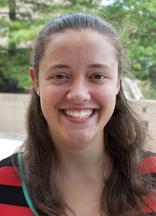
Laura Seaman, Ph.D.
17
Chair
Dissertation Title
Research Interest
Chromosomal translocations and aneuploidy are hallmarks of cancer genomes; however, the impact of these aberrations on the nucleome (i.e., nuclear structure and gene expression) are not yet understood. This dissertation aims to understand the changes in nuclear structure and function that occur as a result of cancer, i.e., the 4D Nucleome of Cancer. Understanding of nuclear shape and organization and how it changes over time in both healthy cells as well as cancer cells is an area of exploration through the 4D Nucleome project.
First, I explore healthy cells including periodic changes in nuclear shape as fibroblasts cells grow and divide. Shape and volume changed significantly over the time series including a 17 hour period consistent with the cell cycle. Next, our combined analysis of genome wide chromosome conformation capture and RNA-sequencing data identified regions with different expression or interactions in cells grown in 2D or 3D cell culture.
Next, I elucidate how chromosomal aberrations affect the nucleome of cancer cells. A high copy number region is studied, and we show that around sites of translocation, chromatin accessibility more directly reflects transcription. The methods developed, including a new copy number based normalization method, were released as in the 4D nucleome analysis toolbox (NAT), a publicly available MATLAB toolbox allowing others to use the tools for assessment of the nucleome.
Finally, I describe some continuing projects. By comparing cancer stem cells to non-stem cell like cancer cells, a bin on chromosome 8 is identified as changing that includes two stem cell related transcription factors, POU5F1B and MYC. Then tools for evaluating allele specific expression are developed and used to measure how allele specific structure and function varies through the cell cycle. This work creates a foundation for robust analysis of chromosome conformation and provides insight into the effect of nuclear organization in cancer.
